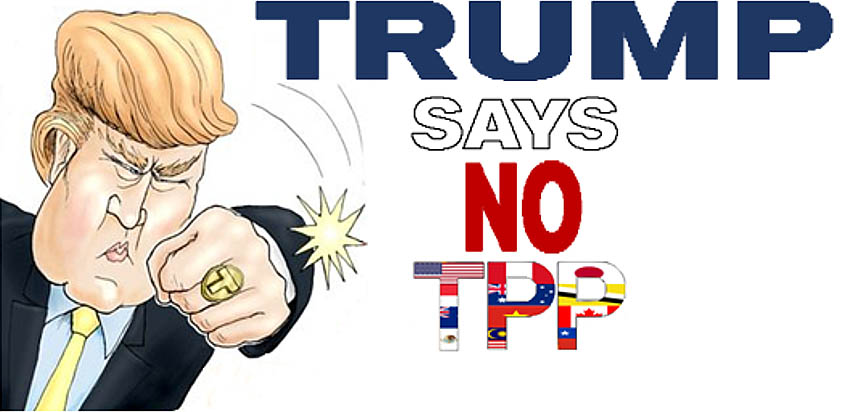With the election of Donald Trump to the White House, the Obama Administration has finally accepted the inevitable and has announced that it will cease efforts to push the Trans Pacific Partnership (TPP) forward in the waning days of the lame-duck session of Congress. From a U.S. perspective, the TPP is now dead. For the eleven other TPP partners, this announcement is a disappointment, although not an unexpected one given the opposition to the TPP demonstrated by both Trump and Hillary Clinton. Japan has already passed TPP legislation and there is legislation pending in the New Zealand Parliament. In Canada, the Liberal Party, which inherited the TPP from its predecessors, has been conducting hearings on the treaty. However, while opponents received ample airtime, the hearings were really just a way to “rag the puck”, running out the time until it became clearer what would happen in Washington.

With the U.S. unwilling to ratify the agreement that was signed in February, it cannot go ahead unless it is revised. Under its current terms, it can only come into force if at least 6 of the 12 original members, comprising 85 percent of the combined GDP of all members (in 2013), agree to proceed. With the U.S. and Japan having a combined share of about 80 percent of combined GDP, this effectively gives both countries a veto (the U.S. share is about 62 percent). Whether the remaining eleven would be interested in proceeding without the U.S. is debatable since gaining exclusive access to the U.S. market was the main priority for many member countries.
So where does this leave businesses and exporters in the U.S. and other TPP countries? Most of the other TPP players have another string to their bow. Australia, New Zealand, Singapore, Malaysia, Vietnam, Brunei and Japan are parties to the Regional Comprehensive Economic Partnership (RCEP) Agreement, which is currently under negotiation. RCEP includes all 10 countries in the Association of Southeast Asian Nations (ASEAN) plus Japan, China, Korea, India, and Australia and New Zealand. Chile, Peru, and Mexico are members of the newly formed Pacific Alliance (PA), which is engaged in liberalizing trade in the Latin America region. Along with Canada, Mexico is a North Atlantic Free Trade Agreement (NAFTA) partner alongside the U.S. However, being a member of NAFTA these days is not very reassuring given what Trump has said about revising — or scrapping — the 20-year-old agreement that has worked well for all three partners.
While the TPP was accused of being negotiated in secret, the same is true of the RCEP. And although the TPP text became publicly available after final agreements were reached, the terms of the RCEP remain vague. It is generally accepted that based on bilateral agreements between the ASEAN partners and the six countries that are the ASEAN bloc’s main trade partners, that RCEP represents lower ambition and benefit in terms of bringing down trade barriers in comparison to the TPP. However, in addition to trade in goods, RCEP includes trade in services, investments, intellectual property rights, competition policy, and dispute settlement and technical cooperation. The agreement also includes China, the world’s second-largest economy. Despite the inevitable carve-outs for sensitive sectors and long phase-ins for some products, when the agreement is finalized, it will create a preferential trade zone for its members that will cover 45 percent of the world’s population with a combined GDP of $22 trillion, while accounting for 40 percent of global trade. It will be the world’s largest trade bloc—and the U.S. will be on the outside looking in.
For U.S. companies exporting to or operating in the region, it will likely lead to more outsourcing as companies seek to get inside the RCEP zone. As the Asian Trade Centre in Singapore has commented:
"Companies hoping to remain competitive—and particularly those working in export markets—will have to work much harder now. Absent trade preferences, firms are at a disadvantage relative to competitors in places like Asia or Europe. The outsourcing that Trump has complained about is likely to accelerate. Firms that want to take advantage of benefits conferred through deals like the Regional Comprehensive Economic Partnership (RCEP) in Asia will need to be located in Asia to provide goods and services to these faster growing, significant markets."
This, of course, is the opposite outcome for which Trump has been advocating.
The TPP is supposed to be one of the “pathways” (alongside the RCEP and the Pacific Alliance) to a much broader Free Trade Area of the Asia Pacific (FTAAP), a mega regional agreement that would combine and multiply the benefits of its components. China has been pushing the FTAAP as an ultimate goal, and APEC has even agreed to a “strategic study”, co-chaired by China and the U.S., to explore the ways in which the TPP and RCEP could be made compatible and mutually reinforcing. While the FTAAP would bring China into a larger, presumably higher-discipline treaty, the U.S. has preferred to focus first on the TPP, which would become a building block of any larger trade agreement. In this way, it would have the first-move advantage and set the bar for the FTAAP. Many U.S. industries would benefit from the lowering of trade barriers and more transparent rules in many areas, from investment-dispute settlement to intellectual-property rights to environmental and labor standards. However, that strategy is out the window—at least for the foreseeable future.
The risk is that the U.S. will be seen as turning its back on Asia. China will push to conclude the RCEP, making the RCEP a template for broader trade within the region. Countries in the Western Hemisphere will see a divide down the Pacific.
For North American businesses operating in Asia, it will be important to maintain an active presence in the region and to take advantage of new trade blocs if and when they emerge. As noted, it may mean that companies will have to localize their presence. Existing bilateral agreements, such as the FTAs that Korea has with the U.S., Canada and Chile will help. With the collapse of the TPP, Canada can be expected to revive its bilateral free-trade discussions with Japan that were suspended when Japan joined the TPP negotiations (Japan already has an agreement with Chile). It may be time for the U.S. and Japan to consider a bilateral agreement based on the groundwork that has been laid through the TPP negotiations — although with Trump setting trade policy, it is hard to imagine that this will be a priority.
China is facing its own economic challenges as its economy slows. Beijing is looking for ways to boost growth, such as the Belt and Road Initiative and by increasing domestic demand. Giving RCEP a push to reach a successful conclusion (perhaps by making some concessions to provide momentum) would be another way to stimulate economic activity, particularly if Trump follows through on threats to disrupt Chinese exports to the U.S. It would also establish Chinese leadership vis a vis ASEAN at a time when U.S. economic commitments to Asia are in question.
Ultimately, over the long term, Washington will need to re-assert its trade presence in the Asia-Pacific region. The supply chains are too interwoven and interdependent for the U.S. to go at it alone, despite the isolationist rhetoric emanating from the U.S. election. For the immediate future, however, the still-birth of the TPP is a setback for U.S. exports, for Western interests in Asia, and for companies, workers, and consumers in both the U.S. and other TPP countries. It will take time to assess and, eventually, remedy the damage.



